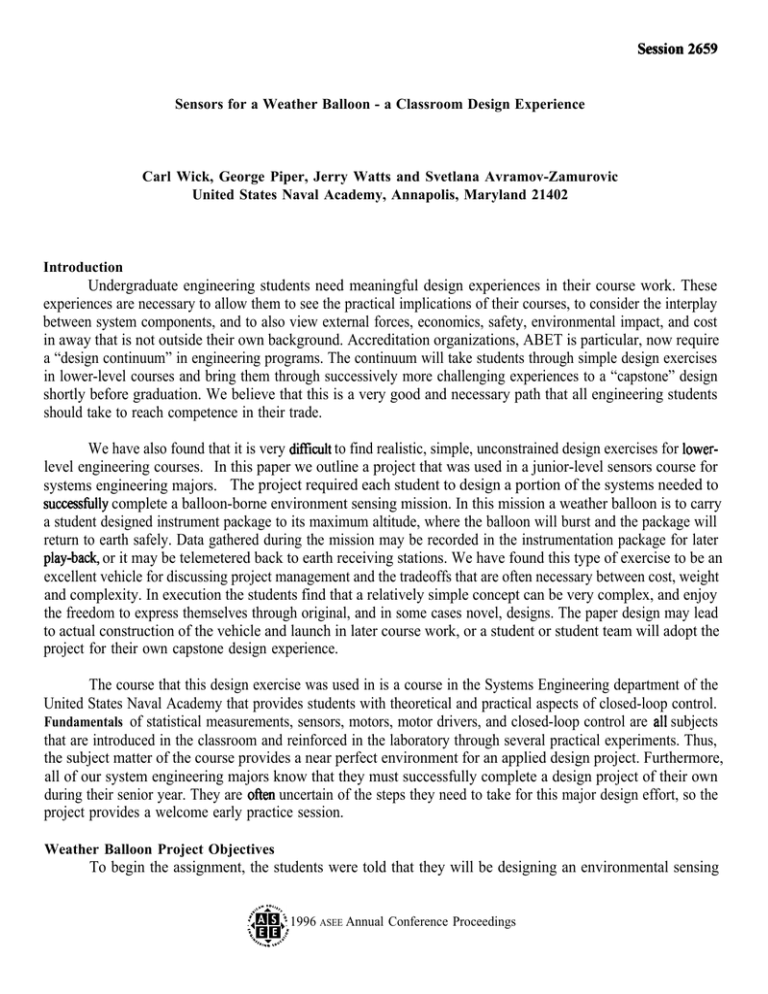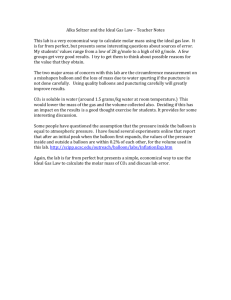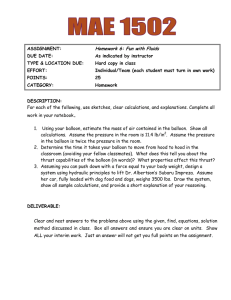Sensors for a Weather Balloon - a Classroom Design Experience
advertisement

Sensors for a Weather Balloon - a Classroom Design Experience
Carl Wick, George Piper, Jerry Watts and Svetlana Avramov-Zamurovic
United States Naval Academy, Annapolis, Maryland 21402
Introduction
Undergraduate engineering students need meaningful design experiences in their course work. These
experiences are necessary to allow them to see the practical implications of their courses, to consider the interplay
between system components, and to also view external forces, economics, safety, environmental impact, and cost
in away that is not outside their own background. Accreditation organizations, ABET is particular, now require
a “design continuum” in engineering programs. The continuum will take students through simple design exercises
in lower-level courses and bring them through successively more challenging experiences to a “capstone” design
shortly before graduation. We believe that this is a very good and necessary path that all engineering students
should take to reach competence in their trade.
We have also found that it is very diffkult to find realistic, simple, unconstrained design exercises for lowerlevel engineering courses. In this paper we outline a project that was used in a junior-level sensors course for
systems engineering majors. The project required each student to design a portion of the systems needed to
successfi.dly complete a balloon-borne environment sensing mission. In this mission a weather balloon is to carry
a student designed instrument package to its maximum altitude, where the balloon will burst and the package will
return to earth safely. Data gathered during the mission may be recorded in the instrumentation package for later
play-back or it may be telemetered back to earth receiving stations. We have found this type of exercise to be an
excellent vehicle for discussing project management and the tradeoffs that are often necessary between cost, weight
and complexity. In execution the students find that a relatively simple concept can be very complex, and enjoy
the freedom to express themselves through original, and in some cases novel, designs. The paper design may lead
to actual construction of the vehicle and launch in later course work, or a student or student team will adopt the
project for their own capstone design experience.
The course that this design exercise was used in is a course in the Systems Engineering department of the
United States Naval Academy that provides students with theoretical and practical aspects of closed-loop control.
Fundamentals of statistical measurements, sensors, motors, motor drivers, and closed-loop control are all subjects
that are introduced in the classroom and reinforced in the laboratory through several practical experiments. Thus,
the subject matter of the course provides a near perfect environment for an applied design project. Furthermore,
all of our system engineering majors know that they must successfully complete a design project of their own
during their senior year. They are often uncertain of the steps they need to take for this major design effort, so the
project provides a welcome early practice session.
Weather Balloon Project Objectives
To begin the assignment, the students were told that they will be designing an environmental sensing
?@xti; 1996 ASEE Annual Conference Proceedings
‘O.+,yyy’:
package that will be sent aloft with a meteorological balloon and that the information that is gathered will be
radioed by a telemetry system to receiving stations for further processing. They were to design a sensor (later
broadened to a sensor or other flight system) that will meet a broad set of preliminary specifications that were
given to them at that time. They were informed that they could use their classroom knowledge and experience to
choose the types of sensors, structure and other system details that were necessary to fulfill the mission
requirements . They are also told that their final design (in the form of a report) would be judged upon its
adherence to specifications, build-ability and reliability. Other factors like realistic cost and system safety were
also considered. During the course of the semester, the students were provided with other supplemental information
ons ystem design steps, areas to research, catalogs and sensor trade publications, and a set of “lessons learned”
notes that came from other amateur weather balloon groups. One of the more well know groups, Edge of Space
Sciences (EOSS), based in Colorado, has much usefil information available on the internet [1], which was
distributed to the students.
Guided Design
Our experience in capstone designs shows that when students are faced with a design project for the first
time they commonly encounter the following pitfalls:
The “open-field syndrome” The vast possibilities that a student is faced with when confronted with an openended problem is sometimes overwhelming. They don’t know in which direction they should proceed since
there are generally many solutions to the problem.
They do not thoroughly think through their project from beginning to end. The student will come up with a
design without investigating all the issues involved. They will then proceed with their design only to discover
a major flaw when they are well into the project. They need to investigate how their solution impacts other
aspects of the project, does their solution work for all contingencies, and what are all the other contingencies.
The scope of their project is too large or unrealistic. Enthusiastic students often come up with large ill-defined
projects. Enthusiasm and motivation are desirable qualities and should be encouraged. However, without
fbcusing their objectives, the project maybe unattainable within the framework of the course thus resulting with
the student coming up empty handed at the end of the course.
Allowing students to struggle with these pitfhlls can lead to them learning valuable lessons. Yet, providing
a structured design procedure with guidance and constant feedback will produce better results.
The weather balloon project was intended to introduce the students to a structured design process that helps
them avoid the common pitfalls associated with open-ended problems. Classroom discussions and assignments
focused on developing well defined objectives, flushing out unforeseen issues, gathering information, and making
tradeoffs. The design process that was used paralleled the steps recommended by Wales and Nardi [2].
Each student started the task by performing a mission analysis and submitting a complete outline of the
balloon’s anticipated flight profile. This activity got the students thinking about launch location, launch
preparatio~ ascent, descent, operating environment, and recovery of the balloon. In addition to the outline, each
student was asked to come up with ten questions about the balloon’s mission. The questions motivated the students
to think about what kind of information they needed and helped them identify issues. The student’s questions were
compiled into a list that was distributed to the class for discussion. The students were amazed at the various issues
that arose from these questions. They ranged from the balloon’s limitations to legal restraints on the mission.
<’hxij 1996 ASEE Annual Conference Proceedings
‘.,+,qlll’,?
For the next phase of the project, each student was required to define a sensor experiment. They selected
an environmental property to measure, such as temperature or pressure, then proposed away to measure it. Their
-r experiment had to comply with the weather balloon’s payload that was specified by the course instructors.
The payload specifications were originally intended to provide guide lines for the student’s sensor experiments.
However as the project proceed~ a number of students expressed interest in other facets of the project such as the
telemetry and the recovery systems. The project’s scope was then expanded so that the students were responsible
for all facets of the project. They established their own requirements and design constraints based on tradeoffs they
performed. The students submitted their proposal to their instructor for approval. Their proposal was to define
their experiment or subsystem and specify any requirements needed for their design. The instructors reviewed the
proposals for problem definition, feasibility, and relevant content. They then provided feedback and guidance to
the student indicting weak points in their proposal.
Once the students proposal was approved they proceeded to develop a detailed design. The students were
encouraged to keep an engineering notebook to record their calculations, assumptions made, resources used, etc.
Some of the instructors collected the notebooks to track the students progress. At the end of the semester the
students submitted a final design document providing sufficient information and drawings to facilitate the
construction of their sensor experiment or subsystem. The design documents were to contain the following
information as a minimum:
A. DESIGN GOALS A discussion of the principal goals their design is trying to achieve. What is their
subsystem suppose to accomplish?
B. SYSTEM DESCRIPTION A description of their system concept in simple easy to understand language.
The description should include sketches, diagrams, and schematics that illustrate the device and identify
relationships between their subsystem and the overall system. Relevant equations and algorithms should
be presented.
C. SCHEDULE A description of all tasks required to accomplish the design. A timeline that shows the
chronological order and the amount of time required for each the task.
D. PARTS LIST A complete list of equipment hardware, software, and parts that are needed to accomplish
the design. The list must include where the part can be acquired, its availability, and cost. Items that may
take considerable amount of time to make or acquire must be annotated so builders can order these parts,
or determine an alternate part or source.
E. RISK ASSESSMENT Identify tasks thatmust to be performed in a specified sequence. If any task in
this sequence is not completd the remaining task can not proceed. This type of sequence is often referred
to as a “critical path”. Identify elements of the design that are critical to its success. If any of these
elements fail, the design will fail.
F. TEST PLAN A test procedure assuring that the system will meet its objectives.
The Student Experience - Results
A panel of instructors selected four final design documents to incorporate into a weather balloon that was
going to be flown the following term. The selected design documents were based on completeness of design,
feasibility, reliability, and originality. This gave the project a competitive flare that motivated some very interesting
{hx~~ 1996
‘@ltHlt’:
ASEE
Annual Conference Proceedings
designs. Below is a brief summary of two of the selected designs.
Project 1. Altimeter Using a Pressure Sensor
The design will consist of three main components: a voltage regulator, the pressure sensor, and an
instrumentation amplifier. The first component the voltage regulator, is essential for clean operation of the sensor.
The payload section of the balloon will be powered by five high-energy lithium batteries in series, providing 15
v. supply. This will be regulated to +5v. and +12v. for use by the components. . . . The voltage regulator to be used
for this circuit is shown in Figure 1. The second component of the altimeter is the pressure sensor. The sensor
chosen is the SenSyrn SCX15ANC absolute pressure sensor. This sensor was chosen for its low cost and reliability
over a broad range of temperatures. The SCX15ANC is internally calibrated with built in temperature
compensation for accurate and stable output form O“C to 70”C, and is capable of operation from -40”C to 85”C. In
the compensated range of temperatures, the device is accurate to +/-1%. Outside this range, the error of the sensor
increases non-linearly and will produce a maximum error of +/-3 .9°/0.
Project 2. Temperature Sensor
The main components of the temperature sensor area thermistor, transistors, and a 555 timer. This sensor’s
output (a square wave) will vary in frequency with varying temperature. The 555 timer is an oscillator that varies
according to the capacitor and resistance values at pins 6 and 7. The formula by which the frequency varies is:
f= 0.722
(&+R)C
where I&is the resistance of the themistor which decreases as the temperature increases. This thermistor is chosen
so that it is linear from -50°C to 10O”C, which is the anticipated range of temperature seen by the weather balloon
in going from sea-level to the burst altitude of 75000 feet. Fig. 2 shows the 555 timer hookup for the terrnistor.
Conclusions
The students in some sections of the course presented their designs to the rest of the class at the end of the
semester. They prepared 10-15 min presentation dkcussing their experience with the project. Most of the reactions
were very positive: they stated that they learned a lot about “real” components in manufacturers catalogs and in
their applications. The serious challenge for them was interfacing the various types of devices needed for the whole
system to work.
The students were encouraged to network and seek information from various sources instead of directing
all of their concerns to one professor. The networking included communication between the students, which was
promoted in class by publishing student responses to early assignments. Most of the students found interacting with
other instructors and departments very interesting and they were pleased with the engineering society
professionalism; some students preferred just talking to professors. Most students took pride in their designs and
after performing some testing and iteratively changing the details of their project they became quite confident and
could discuss the advantages and disadvantages of different solutions.
The weather balloon project was an equally pleasant experience for the faculty. Our students were
enthusiastic about the project and clearly enjoyed finding appropriate solutions engineering problems. The major
lessons we learned were to schedule the project so that an actual launch could be achieved towards the end of the
semester (this time we were notable to successfully launch the experiment), and to make the exercise a formal part
of the course, rather than an additional classroom exercise. Finally, each instructor felt that this was an excefient
,.g 0,,,
@H~ 1996 ASEE Annual Conference Proceedings
‘.<+,HyyL.$
vehicle for teaching undergraduate students about the craft of applied engineering design.
References
[1]
Mullenix, Dave, Balloon FAQ (frequently asked questions).
(http://www.usa. net/-rickveossshtm)m).
[2]
Wales, C. E., and Nardi, A., “Teaching decision-making with guided design,” Idea Paper No. 9, Center for
Available on Internet
faculty Evaluation and Development, Kansas State University, Manhattan, KS, Nov. 1982.
Biographical Information
Carl Wick received the D. SC. in Computer Science from the George Washington University in 1993. He is an
Assistant Professor with the Weapons and Systems Engineering department at the United States Naval Academy
since 1990, when he retired from naval service as an aerospace engineering duty officer. His research interests
are in image processing, fuzzy logic control, digital communications systems and embedded computer systems.
George Piper recieved the Ph.D. in Mechanical Engineering from Drexel University in 1990. Since 1994 he has
been an Assistant Professor with the Weapons and Systems Engineering department at the United States Naval
Academy. Proir to joining the Naval Academy, Dr. Piper was a senior member of the technical staff at Martin
Marietta’s Astro Space Division. At Martin Marietta he was involved in the design of many successfid satellite
programs such as NASA’s Advanced Communications Technology Satellite (ACTS), U.S. Air Force’s DMSP
meteorological satellites, and AT&T’s Telstar IV satellites. His research interest include spacecraft attitude
dynamics & control, and noise& vibration control.
Jerry Watts received college training in Oregon, Louisian~ Utah, and Californi~ receiving the Ph.D. degree in
Systems Engineering from the University of California--Irvine in 1975. He has since taught in the Weapons and
Systems Engineering Department at the U. S. Naval Academy. His research specialty is the modeling and control
of gas turbine engines.
Svetlana Avramov-Zamurovic received the Ph.D. in Electrical Engineering from the University of Maryland in
1994. At present she is an Assistant Professor with the Weapons and Systems Engineering department at the United
States Naval Academy. From 1990 to 1994, Dr. Avramov-Zamurovic was involved in developing a measurement
bridge for voltage ratio calibration for NASA space experiment Zeno. She was Guest Researcher at the National
Institute of Standards and Technology (MST) from 1990 to 1994. During the summer of 1995 she was involved
in development of capacitance ratio bridges to support the Single Electron Tunneling Experiment at NIST. Her
research interests include precision measurements of electrical units, in particular the development of bridges to
measure impedance and voltage ratios.
~hxti~ 1996
‘.<#lllHll’.?
ASEE
Annual Conference Proceedings
I
Fig. 2 Using a thermistor to control the pulses of a 555 timer.
‘“2”%
@H~ 1996 ASEE Annual Conference Proceedings
‘.,.,cxy$::
.







